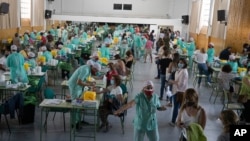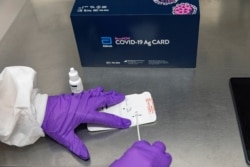As the COVID-19 pandemic marches on, new, rapid tests offer hope for pumping the brakes on the virus’ spread.
The United States is falling far short in its testing efforts. More than 4 million tests per day would be needed to control the spread of the coronavirus, according to an analysis by Brown University and NPR. But more than six months into the outbreak, daily tests still have not reached 1 million per day, data from the COVID Tracking Project shows.
The latest tests can be completed during a healthcare visit, providing a result in just 15 to 30 minutes. Some of the tests could eventually be used at home.
Rapid tests solve some of the problems of sample shipping delays, equipment shortages and laboratory backlogs that have plagued U.S. testing. But not all tests are equally accurate, leading to different opinions about the best testing approach.
“A test is ideally a rapid test, meaning results come back in an hour,” said David Weber, professor of medicine, pediatrics and epidemiology at the University of North Carolina. “The faster the test comes back, the quicker you can tell someone to isolate themselves or that they don't need isolation, or you can do your contact tracing.”
Types of testing
Testing is crucial to slowing virus spread because it “identifies individuals before they can become contagious so that they can isolate and protect those around them,” said Anne Wyllie, epidemiology researcher at Yale University. “Knowing where [the virus] is and being able to stop or slow spread is what's going to help us stamp it out.”
Two types of tests identify people who are currently infected with COVID-19.
The first, a type of test scientists call PCR, looks for the virus's genetic material. The second, known as an antigen test, recognizes viral proteins.
Often lauded as the gold standard for testing, PCR is highly accurate. However, most of these tests have to be shipped to laboratories where they are processed by trained personnel and special equipment. Depending on the test and clinic, wait times for results vary widely from hours to a week or more.
Antigen tests are less sensitive and accurate than PCR tests, but they provide results much faster, usually in less than 30 minutes.
Rapid developments
A benefit of the latest PCR tests is that they can be performed at a doctor’s office by staff with minimal training, producing a result in just 15 to 30 minutes. A nose or throat swab sample is loaded into a special cartridge that is processed by a toaster-sized machine.
A handful of rapid PCR tests have been granted U.S. Food and Drug Administration emergency use authorizations (EUAs), some of which can simultaneously test for COVID-19, influenza and other respiratory viruses.
However, rapid tests may not be the most efficient approach for testing many samples at once.
“The thing with those [rapid tests] is that it’s 30 minutes for one test. Whereas [laboratory PCR testing] can process 92 in three hours,” said Wyllie.
Rapid PCR tests can also be expensive. Sample cartridges may cost $20 or more and machines may cost thousands of dollars.
Although less accurate than PCR, antigen tests offer faster and cheaper testing. One of these, Abbott’s BinaxNOW test is a simple paper card that works like a pregnancy test, delivering a yes-or-no result in just 15 minutes. The test costs just $5 per sample.
The U.S. Department of Health and Human Services recently announced it purchased 150 million BinaxNOW tests for deployment in schools.
The right test for the job
Experts say that the best test depends on the testing strategy.
“I think there's definitely a time and a place for all of these tests, as long as they’re used properly,” said Wyllie.
Currently, the CDC only recommends COVID-19 testing if people have symptoms or if they’ve been in close contact with an infected person. Because PCR picks up even tiny quantities of the virus it is much more sensitive than antigen testing.
This means that PCR can more accurately diagnose COVID-19, particularly as the disease progresses and virus levels wane.
“PCR is extremely sensitive. It can detect one molecule [of the virus],” said Michael Mina, epidemiology professor at Harvard University at a press conference. “I want to make it clear that PCR is a terrific tool. If I’m a diagnostic physician, I want to use PCR.”
However, because PCR tests are so sensitive, they may give a positive result when people are no longer contagious. “We’re actually missing people during the peak of their infection and we’re catching them too late,” said Mina.
Some experts say the best approach to tackling COVID-19 is frequent, widespread testing of asymptomatic people. Less-sensitive antigen tests may do the job because they perform well when virus levels are high and detect people when they’re most infectious. Best of all, these tests are cheap and quick.
“If my goal is to use testing as a way to remove people who are infectious from the population, that’s where these rapid antigen tests really start to shine,” said Mina.
According to Mina, the recent granting of an Emergency Use Authorization to a rapid antigen test is a step in the right direction. This type of simple, paper test could one day be available for use in homes.
Although the FDA has not yet approved a home COVID-19 test, it recently provided recommendations for home testing standards, stating that these tests will be a “game changer in our fight against COVID-19.”
“I really like the idea of a rapid test that you can do at home,” said Yale’s Wyllie. “This idea that we can get up in the morning and as we’re getting ready for work or whatever, taking a test.”
But Wyllie says the success of this approach depends on test sensitivity and how often testing is done. “The problem with antigen tests at the moment is that I just don't think they're sensitive enough sometimes.”
Even with daily testing, a low sensitivity test could fail to identify the virus before a person becomes infectious. “In that 24 hours, they could go to a wedding, they could go to a funeral, they could go to a church choir. All these settings that we’re seeing become superspreading events.”
The limits of testing
Experts agree that no test is perfect. Results depend on many factors such as the type of test, how the sample was collected and when the test was taken.
“A negative [diagnostic] test doesn't exclude the possibility that you will test positive tomorrow if you're within that 14-day incubation period,” said UNC’s Weber. “I think testing is an important strategy but it's not a substitute for physical distancing and mask wearing.”
Steve Baragona contributed to this report.








